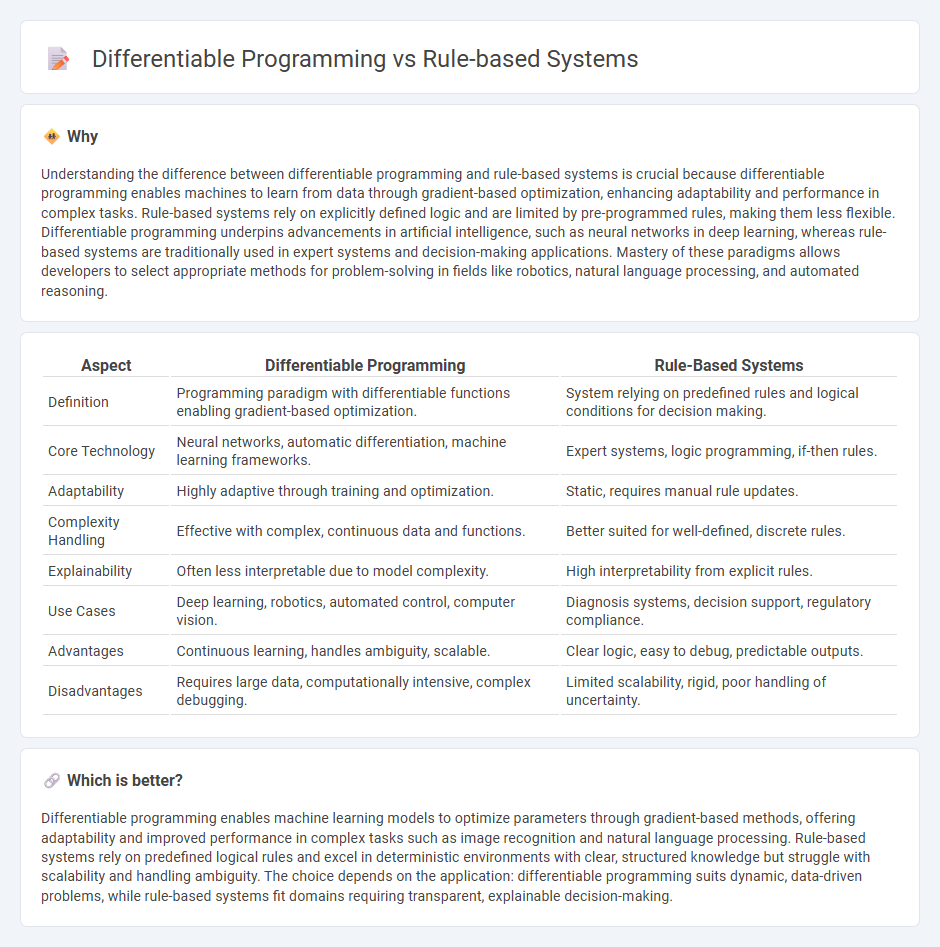
Differentiable programming leverages continuous optimization by integrating neural networks and gradient-based methods, enabling models to learn complex patterns from data. Rule-based systems rely on predefined logical rules and expert knowledge to execute decisions in a structured, deterministic manner. Explore how these distinct approaches impact AI development and practical applications.
Why it is important
Understanding the difference between differentiable programming and rule-based systems is crucial because differentiable programming enables machines to learn from data through gradient-based optimization, enhancing adaptability and performance in complex tasks. Rule-based systems rely on explicitly defined logic and are limited by pre-programmed rules, making them less flexible. Differentiable programming underpins advancements in artificial intelligence, such as neural networks in deep learning, whereas rule-based systems are traditionally used in expert systems and decision-making applications. Mastery of these paradigms allows developers to select appropriate methods for problem-solving in fields like robotics, natural language processing, and automated reasoning.
Comparison Table
| Aspect | Differentiable Programming | Rule-Based Systems |
|---|---|---|
| Definition | Programming paradigm with differentiable functions enabling gradient-based optimization. | System relying on predefined rules and logical conditions for decision making. |
| Core Technology | Neural networks, automatic differentiation, machine learning frameworks. | Expert systems, logic programming, if-then rules. |
| Adaptability | Highly adaptive through training and optimization. | Static, requires manual rule updates. |
| Complexity Handling | Effective with complex, continuous data and functions. | Better suited for well-defined, discrete rules. |
| Explainability | Often less interpretable due to model complexity. | High interpretability from explicit rules. |
| Use Cases | Deep learning, robotics, automated control, computer vision. | Diagnosis systems, decision support, regulatory compliance. |
| Advantages | Continuous learning, handles ambiguity, scalable. | Clear logic, easy to debug, predictable outputs. |
| Disadvantages | Requires large data, computationally intensive, complex debugging. | Limited scalability, rigid, poor handling of uncertainty. |
Which is better?
Differentiable programming enables machine learning models to optimize parameters through gradient-based methods, offering adaptability and improved performance in complex tasks such as image recognition and natural language processing. Rule-based systems rely on predefined logical rules and excel in deterministic environments with clear, structured knowledge but struggle with scalability and handling ambiguity. The choice depends on the application: differentiable programming suits dynamic, data-driven problems, while rule-based systems fit domains requiring transparent, explainable decision-making.
Connection
Differentiable programming enhances rule-based systems by integrating gradient-based optimization to improve the adaptability and learning capacity of predefined rules. This combination enables systems to adjust parameters continuously through data-driven feedback, bridging symbolic logic with neural computation. The synergy facilitates advanced AI models that leverage explicit knowledge representation alongside flexible, data-informed updates.
Key Terms
IF-THEN Rules
Rule-based systems rely on explicit IF-THEN rules to encode human knowledge and decision logic, offering transparent and interpretable reasoning processes ideal for structured problem domains. Differentiable programming integrates continuous optimization techniques, enabling models to learn representations from data while allowing gradient-based updates, which contrasts with the static nature of traditional rule-based logic. Explore further to understand how merging these paradigms can enhance hybrid AI solutions.
Gradient Descent
Rule-based systems operate through explicit, hand-crafted logic rules lacking gradient-based optimization, making them less adaptable to complex data patterns. Differentiable programming employs gradient descent algorithms to iteratively minimize loss functions, enabling automatic learning and fine-tuning of model parameters. Explore the intricacies of gradient descent to understand its pivotal role in advancing differentiable programming methodologies.
Symbolic Reasoning
Rule-based systems rely on explicit, human-crafted if-then rules to perform symbolic reasoning, enabling transparent and interpretable decision-making processes. Differentiable programming integrates neural network models with continuous optimization techniques, allowing symbolic reasoning tasks to benefit from gradient-based learning and adaptability. Explore how these approaches compare in effectiveness, scalability, and real-world applications for symbolic reasoning tasks.
Source and External Links
Rule-Based System - Engati - A rule-based system applies human-made rules typically in an IF-THEN format to store, sort, and manipulate data, mimicking human intelligence by analyzing facts against its rules and automating actions accordingly, with features like robustness, support for heuristic knowledge, and non-deterministic control strategies.
Rule-based system - Wikipedia - Rule-based systems use domain-specific knowledge encoded as rules and apply general-purpose reasoning, mainly through production systems or logic programming, using forward or backward chaining to derive actions or conclusions from conditions.
Rule-Based System in AI - GeeksforGeeks - In AI, rule-based systems utilize explicit IF-THEN rules and logical reasoning strategies such as forward and backward chaining to generate outputs like decisions or recommendations, making them useful in applications like expert systems and customer service chatbots.
 dowidth.com
dowidth.com